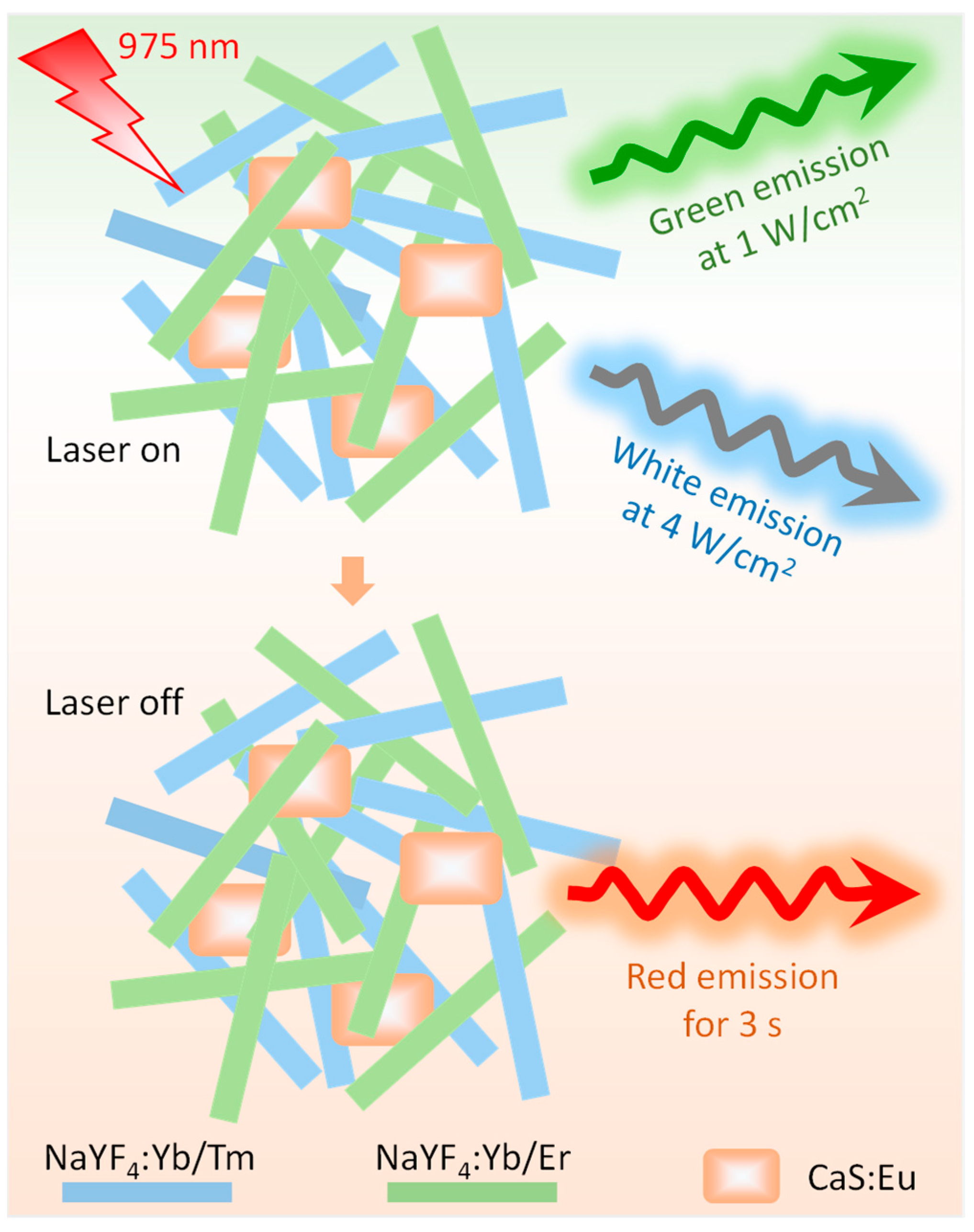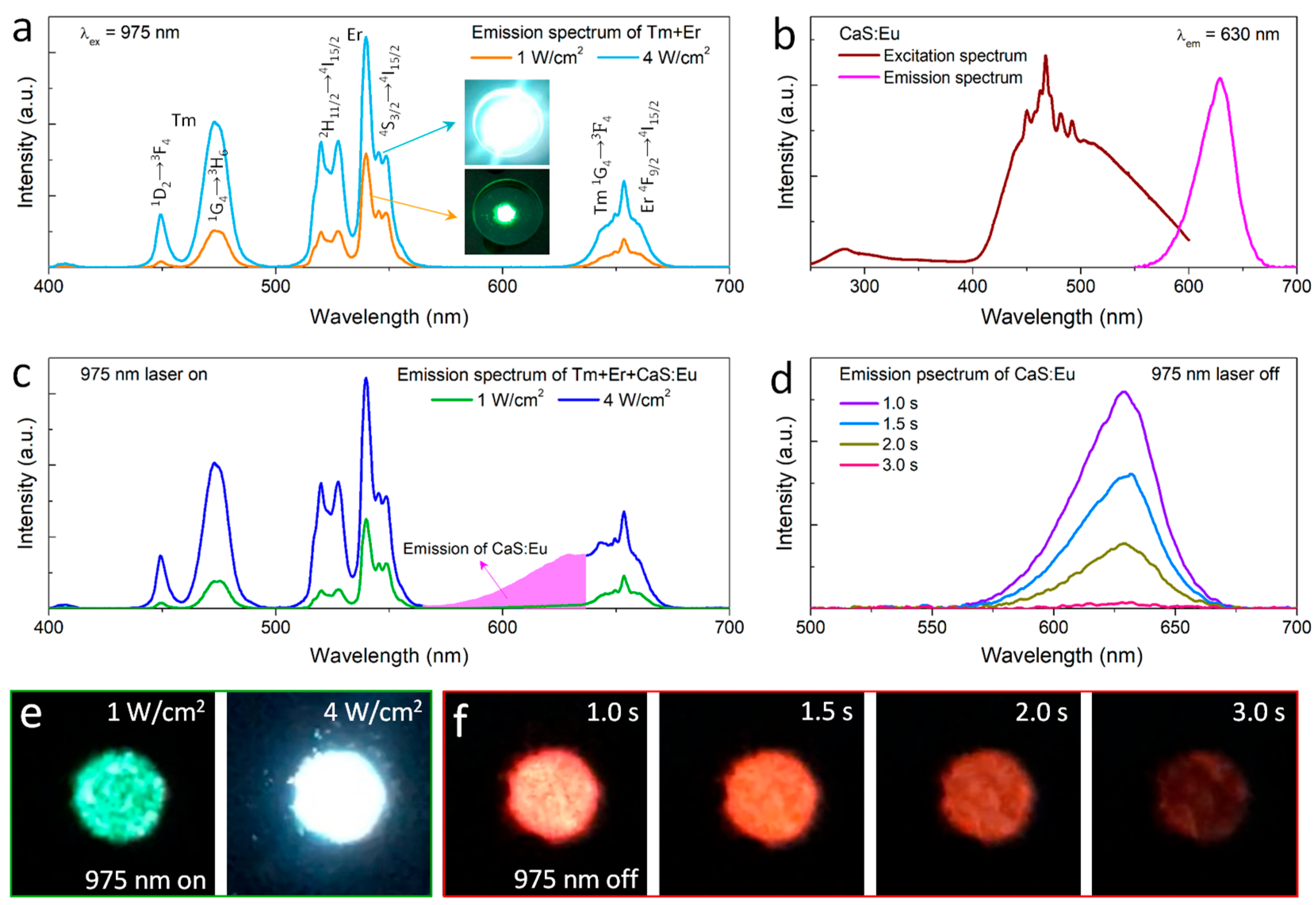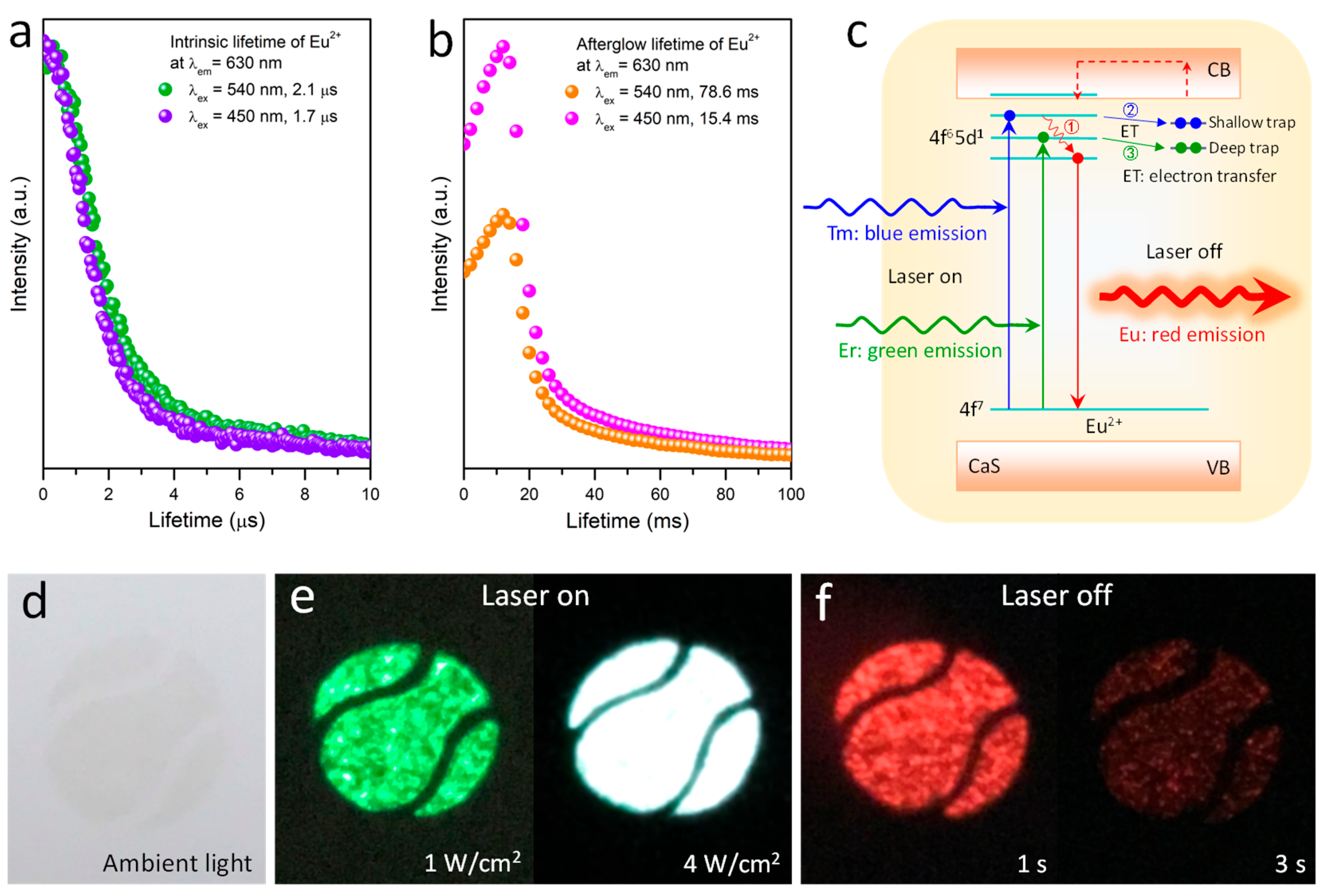Single-Mode-Tuned Tricolor Emissions of Upconversion/Afterglow Hybrids for Anticounterfeiting Applications
Abstract
:1. Introduction
2. Results and Discussion
3. Conclusions
4. Experimental Methods
4.1. Microrod Synthesis
4.2. Characterization
Supplementary Materials
Author Contributions
Funding
Conflicts of Interest
References
- Ren, W.; Lin, G.; Clarke, C.; Zhou, J.; Jin, D. Optical nanomaterials and enabling technologies for high-security-level anticounterfeiting. Adv. Mater. 2020, 32, 1901430. [Google Scholar] [CrossRef]
- Yao, W.; Tian, Q.; Wu, W. Tunable emissions of upconversion fluorescence for security applications. Adv. Opt. Mater. 2018, 7, 1801171. [Google Scholar] [CrossRef]
- Kumar, P.; Dwivedi, J.; Gupta, B.K. Highly luminescent dual mode rare-earth nanorod assisted multi-stage excitable security ink for anti-counterfeiting applications. J. Mater. Chem. C 2014, 2, 10468–10475. [Google Scholar] [CrossRef]
- Xiao, H.; Liu, B.; Qiu, L.; Li, G.; Zhang, G.; Huang, D.; Zhao, Y.; Yang, C.; Jiang, F.; Dang, P.; et al. Core-shell structured upconversion/lead-free perovskite nanoparticles for anticounterfeiting applications. Angew. Chem. Int. Ed. 2022, 61, e202115136. [Google Scholar] [CrossRef]
- Xie, Y.; Song, Y.; Sun, G.; Hu, P.; Bednarkiewicz, A.; Sun, L. Lanthanide-doped heterostructured nanocomposites toward advanced optical anti-counterfeiting and information storage. Light Sci. Appl. 2022, 11, 150. [Google Scholar] [CrossRef]
- Pei, P.; Wei, R.; Wang, B.; Su, J.; Zhang, Z.; Liu, W. An advanced tunable multimodal luminescent La4GeO8: Eu2+, Er3+ phosphor for multicolor anticounterfeiting. Adv. Funct. Mater. 2021, 31, 2102479. [Google Scholar] [CrossRef]
- Dong, H.; Sun, L.D.; Feng, W.; Gu, Y.; Li, F.; Yan, C.H. Versatile spectral and lifetime multiplexing nanoplatform with excitation orthogonalized upconversion luminescence. ACS Nano 2017, 11, 3289–3297. [Google Scholar] [CrossRef]
- Han, Y.; Li, H.; Wang, Y.; Pan, Y.; Huang, L.; Song, F.; Huang, W. Upconversion modulation through pulsed laser excitation for anti-counterfeiting. Sci. Rep. 2017, 7, 1320. [Google Scholar] [CrossRef]
- Zhang, C.; Yang, L.; Zhao, J.; Liu, B.; Han, M.Y.; Zhang, Z. White-light emission from an integrated upconversion nanostructure: Toward multicolor displays modulated by laser power. Angew. Chem. Int. Ed. 2015, 54, 11531–11535. [Google Scholar] [CrossRef]
- Chen, B.; Liu, Y.; Xiao, Y.; Chen, X.; Li, Y.; Li, M.; Qiao, X.; Fan, X.; Wang, F. Amplifying excitation-power sensitivity of photon upconversion in a NaYbF4:Ho nanostructure for direct visualization of electromagnetic hotspots. J. Phys. Chem. Lett. 2016, 7, 4916–4921. [Google Scholar] [CrossRef]
- Liu, J.; Rijckaert, H.; Zeng, M.; Haustraete, K.; Laforce, B.; Vincze, L.; Van Driessche, I.; Kaczmarek, A.M.; Van Deun, R. Simultaneously excited downshifting/upconversion luminescence from lanthanide-doped core/shell fluoride nanoparticles for multimode anticounterfeiting. Adv. Funct. Mater. 2018, 28, 1707365. [Google Scholar] [CrossRef]
- Sun, T.; Xu, B.; Chen, B.; Chen, X.; Li, M.; Shi, P.; Wang, F. Anti-counterfeiting patterns encrypted with multi-mode luminescent nanotaggants. Nanoscale 2017, 9, 2701–2705. [Google Scholar] [CrossRef]
- Lei, L.; Dai, X.; Cheng, Y.; Wang, Y.; Xiao, Z.; Xu, S. Dual-mode color tuning based on upconversion core/triple-shell nanostructure. J. Mater. Chem. C 2019, 7, 3342–3350. [Google Scholar] [CrossRef]
- Hu, Y.; Shao, Q.; Deng, X.; Han, S.; Song, D.; Jiang, J. Core/shell upconversion nanocrystal hybrids with temperature-dependent emission color changes for multilevel anticounterfeiting applications. Adv. Mater. Technol. 2019, 4, 1800498. [Google Scholar] [CrossRef]
- Hu, Y.; Shao, Q.; Deng, X.; Song, D.; Han, S.; Dong, Y.; Jiang, J. Thermally induced multicolor emissions of upconversion hybrids with large color shifts for anticounterfeiting applications. J. Mater. Chem. C 2019, 7, 11770–11775. [Google Scholar] [CrossRef]
- Hu, Y.; Shao, Q.; Deng, X.; Jiang, J. Thermal-responsive multicolor emission of single NaGdF4:Yb/Ce/Ho upconversion nanocrystals for anticounterfeiting application. Nanophotonics 2020, 9, 2879–2885. [Google Scholar] [CrossRef]
- Hu, L.; Fan, Y.; Liu, L.; Li, X.; Zhao, B.; Wang, R.; Wang, P.; El-Toni, A.M.; Zhang, F. Orthogonal multiplexed luminescence encoding with near-infrared rechargeable upconverting persistent luminescence composites. Adv. Opt. Mater. 2017, 5, 1700680. [Google Scholar] [CrossRef]
- Li, Z.; Huang, L.; Zhang, Y.; Zhao, Y.; Yang, H.; Han, G. Near-infrared light activated persistent luminescence nanoparticles via upconversion. Nano Res. 2017, 10, 1840–1846. [Google Scholar] [CrossRef]
- Wang, F.; Han, Y.; Lim, C.S.; Lu, Y.; Wang, J.; Xu, J.; Chen, H.; Zhang, C.; Hong, M.; Liu, X. Simultaneous phase and size control of upconversion nanocrystals through lanthanide doping. Nature 2010, 463, 1061–1065. [Google Scholar] [CrossRef]
- Pollnau, M.; Gamelin, D.R.; Lüthi, S.R.; Güdel, H.U. Power dependence of upconversion luminescence in lanthanide and transition-metal-ion systems. Phys. Rev. B 2000, 61, 3337–3346. [Google Scholar] [CrossRef]
- Huang, L.; Zhu, Y.; Zhang, X.; Zou, R.; Pan, F.; Wang, J.; Wu, M. HF-free hydrothermal route for synthesis of highly efficient narrow-band red emitting phosphor K2Si1–xF6:xMn4+ for warm white light-emitting diodes. Chem. Mater. 2016, 28, 1495–1502. [Google Scholar] [CrossRef]
- Shao, Q.; Zhang, G.; Ouyang, L.; Hu, Y.; Dong, Y.; Jiang, J. Emission color tuning of core/shell upconversion nanoparticles through modulation of laser power or temperature. Nanoscale 2017, 9, 12132–12141. [Google Scholar] [CrossRef] [PubMed]
- Zhang, X.; Zhang, J.; Zhu, Q. Doping upconversion ion pair of Yb3+/Er3+ in ZnGa2O4:Cr3+ for multimode luminescence and advanced anti-counterfeiting. Opt. Mater. 2022, 125, 112100. [Google Scholar] [CrossRef]
- Zhao, S.; Wang, Z.; Ma, Z.; Fan, F.; Liu, W. Achieving multimodal emission in Zn4B6O13:Tb3+,Yb3+ for information encryption and anti-counterfeiting. Inorg. Chem. 2020, 59, 15681–15689. [Google Scholar] [CrossRef]
- Naresh, V.; Adusumalli, V.N.K.B.; Park, Y.I.; Lee, N. NIR triggered NaYF4:Yb3+,Tm3+@NaYF4/CsPb(Br1-x/Ix)3 composite for up-converted white-light emission and dual-model anti-counterfeiting applications. Mater. Today Chem. 2022, 23, 100752. [Google Scholar] [CrossRef]
- Hu, Y.; Shao, Q.; Zhang, P.; Dong, Y.; Fang, F.; Jiang, J. Mechanistic investigations on the dramatic thermally induced luminescence enhancement in upconversion nanocrystals. J. Phys. Chem. C 2018, 122, 26142–26152. [Google Scholar] [CrossRef]



Publisher’s Note: MDPI stays neutral with regard to jurisdictional claims in published maps and institutional affiliations. |
© 2022 by the authors. Licensee MDPI, Basel, Switzerland. This article is an open access article distributed under the terms and conditions of the Creative Commons Attribution (CC BY) license (https://creativecommons.org/licenses/by/4.0/).
Share and Cite
Hu, Y.; Li, S.; Yu, S.; Chen, S.; Yan, Y.; Liu, Y.; Chen, Y.; Chen, C.; Shao, Q.; Liu, Y. Single-Mode-Tuned Tricolor Emissions of Upconversion/Afterglow Hybrids for Anticounterfeiting Applications. Nanomaterials 2022, 12, 3123. https://doi.org/10.3390/nano12183123
Hu Y, Li S, Yu S, Chen S, Yan Y, Liu Y, Chen Y, Chen C, Shao Q, Liu Y. Single-Mode-Tuned Tricolor Emissions of Upconversion/Afterglow Hybrids for Anticounterfeiting Applications. Nanomaterials. 2022; 12(18):3123. https://doi.org/10.3390/nano12183123
Chicago/Turabian StyleHu, Yanqing, Songqi Li, Shijie Yu, Shuoran Chen, Yuyang Yan, Yan Liu, Yuanpeng Chen, Caosong Chen, Qiyue Shao, and Yingshuai Liu. 2022. "Single-Mode-Tuned Tricolor Emissions of Upconversion/Afterglow Hybrids for Anticounterfeiting Applications" Nanomaterials 12, no. 18: 3123. https://doi.org/10.3390/nano12183123
APA StyleHu, Y., Li, S., Yu, S., Chen, S., Yan, Y., Liu, Y., Chen, Y., Chen, C., Shao, Q., & Liu, Y. (2022). Single-Mode-Tuned Tricolor Emissions of Upconversion/Afterglow Hybrids for Anticounterfeiting Applications. Nanomaterials, 12(18), 3123. https://doi.org/10.3390/nano12183123






